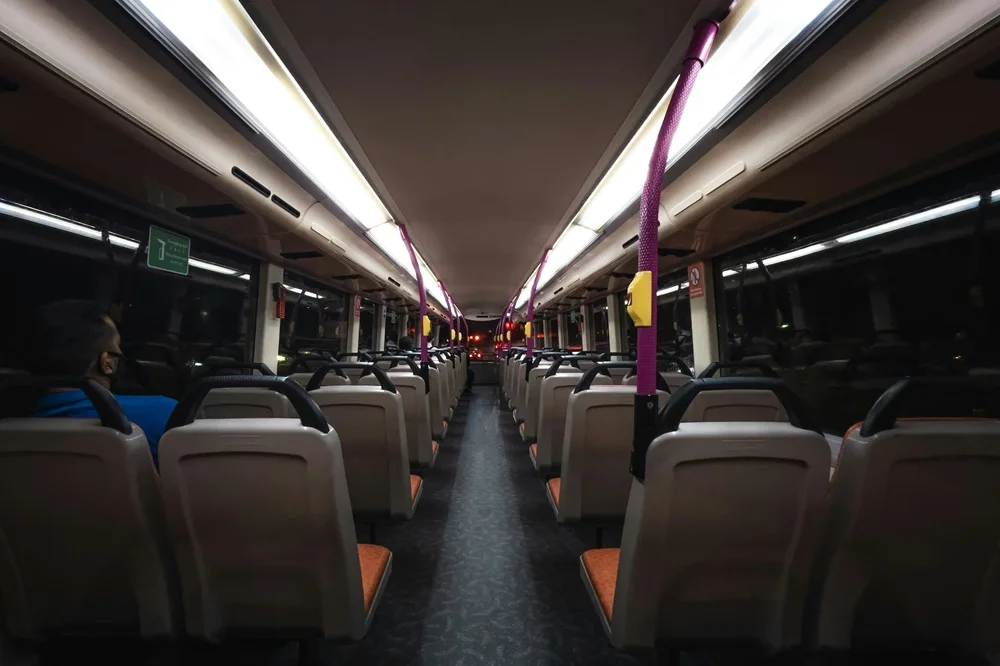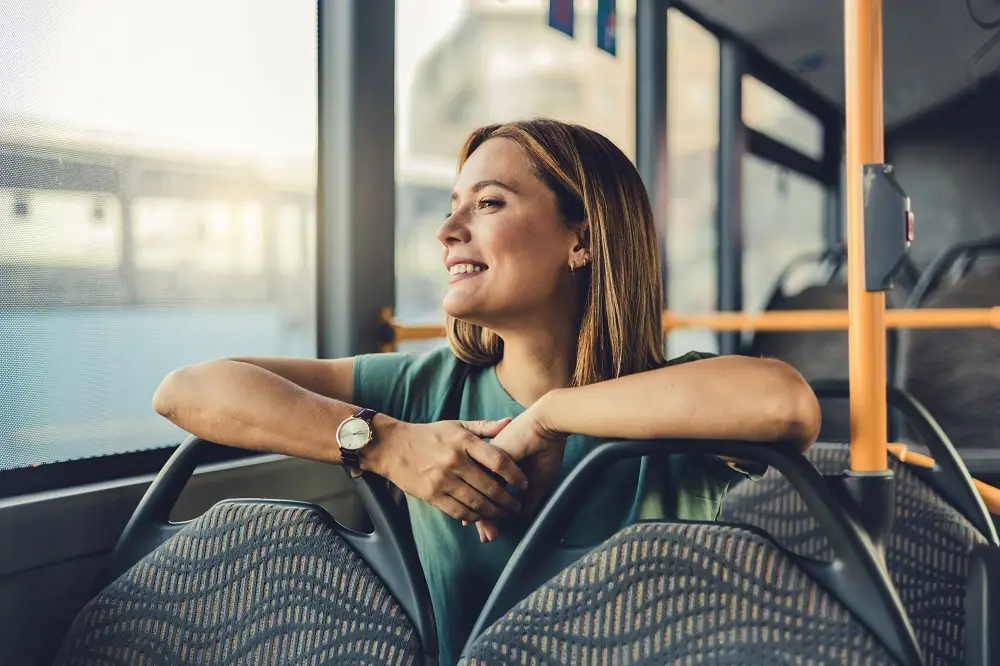Not all school transportation options are the same. The familiar yellow school bus remains the traditional choice for daily routes, while charter buses are widely used for school needs such as field trips, sports, and long-distance travel. Each type serves a specific purpose, with size, layout, and features tailored to different requirements from compact buses for neighborhood streets to spacious charter buses for school field trips designed for comfort on extended trips. Whether you’re arranging daily pickups, a special event in Chicago, or group travel beyond the city, understanding these options ensures safe, comfortable, and efficient student transportation.
4 Types of School Buses: America’s Transportation Backbone
School buses in the U.S. are officially divided into four types: A, B, C, and D. Each type serves a specific purpose, based on passenger capacity, design, and operating needs.
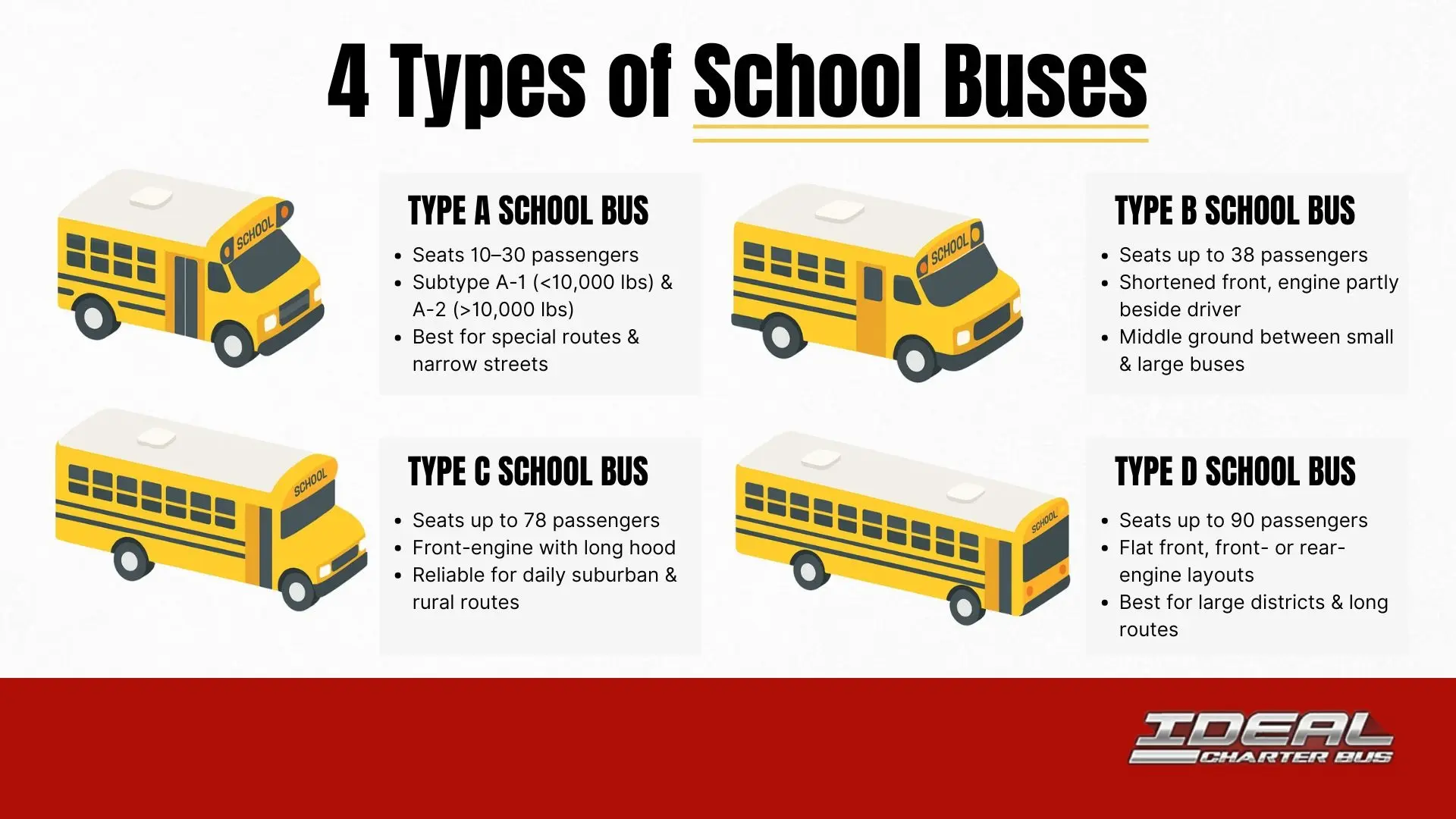
#1. Type A School Bus: Compact and Versatile
Type A buses are constructed using a cutaway front section vehicle, which features a left side driver's door. The bus body is mounted on this chassis, resulting in a compact but practical body design that makes them a good fit for specialized transportation needs.
Two Subtypes
- Type A-1: Under 10,000 lbs GVWR (lighter duty). This classification is based on the bus's weight rating, specifically its gross weight rating, which determines the maximum allowable loaded weight including the vehicle, fuel, passengers, and cargo.
- Type A-2: Over 10,000 lbs GVWR (heavier duty). The distinction here is also defined by the gross weight rating, with a higher weight rating allowing for greater capacity and compliance with safety standards.
Best Uses
- Navigating narrow neighborhood streets
- Transporting students with special needs (easy to customize)
- Serving routes where larger buses would be impractical
- Meeting specific school district needs, such as specialized routes or accessibility requirements
Key Features
- Seating for 10-30 passengers
- ADA modifications available for accessibility
- Cutaway van chassis provides maneuverability
- Driver’s side door located on the left side for smoother operation
- Passenger door positioned behind the front wheels for safe and efficient boarding and exiting of students in Type A buses
#2. Type B School Bus: A Less Common Option

Type B buses are less common but fill an important niche. With the engine partly beneath and beside the driver, they balance compact size with more capacity than Type A.
Best Uses
- Districts needing a middle ground between small and large buses
- Routes that require flexibility without sacrificing too many seats
Key Features
- Distinct shortened front end
- Seating for up to 38 passengers
- Entrance door is typically located behind the front wheels, which is a key design feature
- Requires a CDL with school bus endorsement
#3. Type C School Bus: The Standard Model
This is the most recognizable school bus. Type C buses are known for their conventional design, typically built on a truck chassis or cutaway truck chassis with a hood assembly. Built with a long hood and a front entrance behind the axle, these buses often feature a flat back cowl chassis, which provides structural support for the bus body and accommodates a front-mounted engine. Type C buses are the most widely used across the country.
Best Uses
- Daily routes in suburban and rural areas
- Districts looking for a reliable, all-purpose option
Key Features
- GVWR over 21,500 lbs
- Seating for up to 78 passengers
- Front-engine design for easier maintenance
- Good balance of capacity and maneuverability
#4. Type D School Bus: The High-Capacity Transit Style

Type D buses are the largest transit style buses, featuring flat fronts and a bus body installed directly onto a stripped chassis. This design allows for maximum interior space and capacity. The body is mounted directly to the frame, creating a strong and unified structure.
Best Uses
- High-density routes and large districts
- Long-distance travel where efficiency is important
Key Features
- Seating for up to 90 passengers
- Available in front-engine (FE) and rear-engine (RE) layouts
- Length up to 45 feet with spacious interiors
Beyond the Standard Bus: Specialized Solutions
While traditional school bus types (A through D) are built for daily routes, sometimes schools need more flexible options. In addition to school-operated vehicles like activity buses or vans, many groups turn to charter buses for special occasions. Charter buses are ideal for field trips, athletic events, long-distance travel, or any time comfort and extra capacity are important. They complement standard school buses by providing a safe, reliable, and comfortable way to move students and groups when the trip goes beyond the usual home-to-school route.
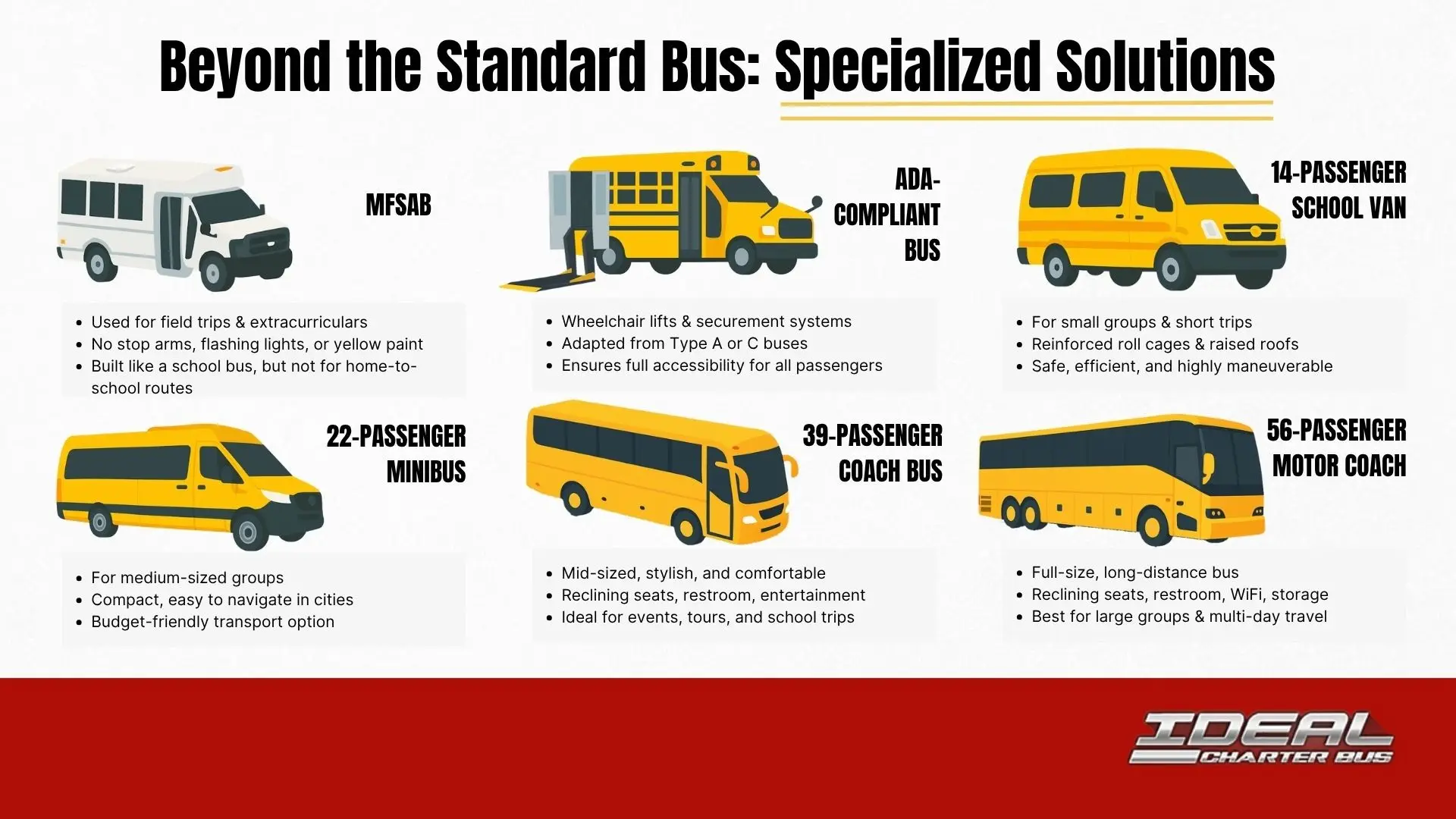
Multifunction School Activity Buses (MFSABs)
A multifunctional activity bus (MFSAB) is a type of activity bus with a body design similar to standard school buses but with differences in appearance and features. These buses serve double duty, built like school buses but used for activities. Unlike regular school buses, a multifunctional activity bus is not required to meet the same conspicuity standards or conspicuity regulations, such as yellow paint, stop arms, or flashing lights.
Best Uses
- Field trips, sports, and extracurricular events
- Any trip that’s not home-to-school
Key Features
- No flashing lights or stop arms
- Often painted in non-yellow colors
- Fully compliant with federal safety standards
ADA-Compliant Buses
Built with accessibility in mind, these vehicles ensure all students can ride safely and comfortably. In addition to meeting federal ADA standards, they also comply with state regulations to guarantee full accessibility for passengers with disabilities.
Best Uses
- Transporting students with mobility challenges
- Inclusive group travel where accessibility is essential
Key Features
- Wheelchair lifts and securement systems
- Climate control for passenger comfort
- Adapted from Type A or C buses for universal access
School Vans (Up to 14 Passengers)
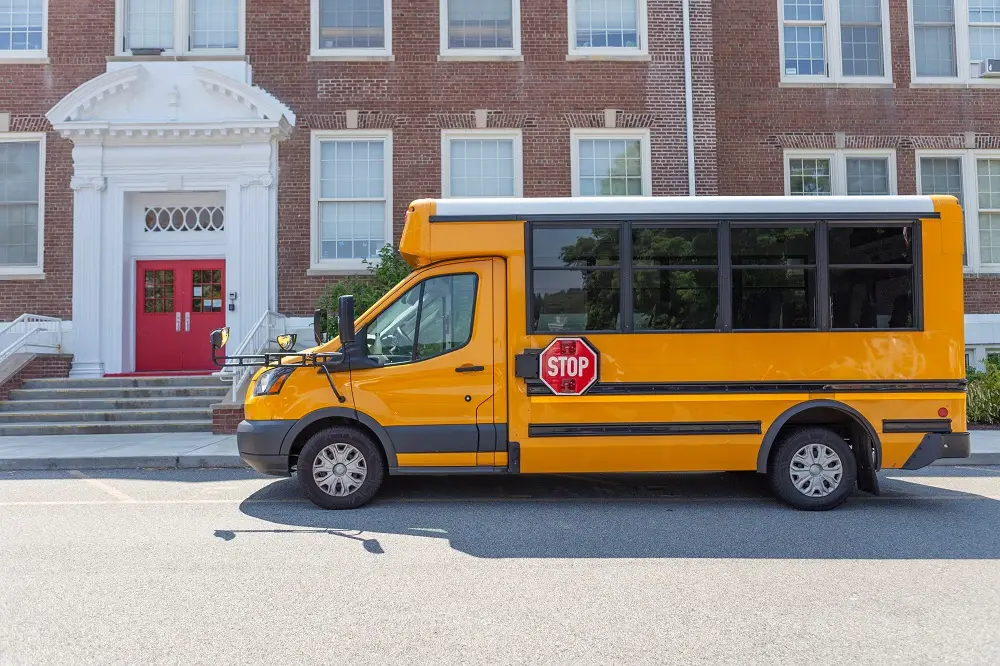
Smaller groups need flexible solutions. School vans, often converted from normal vans such as Ford Transit models, provide safe, efficient transport. Some of these vans are modified to become van taller by cutting and raising the roof, increasing interior height for student comfort and accessibility.
Best Uses
- Equal or fewer than 14 students
- Situations requiring maneuverability and quick trips
Key Features
- Reinforced roll cages for added protection
- Raised roofs for comfort and accessibility
- Interior modifications that meet student transport standards
Minibuses (Up to 22 Passengers)
Compact yet practical, minibuses offer a balance of efficiency and affordability.
Best Uses
- Medium-sized groups
- Urban trips where maneuverability matters
- Cost-conscious transportation needs
Key Features
- Easy navigation in urban areas
- Comfortable seating with overhead storage
- Budget-friendly option for group travel
39-Passenger Coach Bus

A stylish, mid-sized option that combines comfort with practicality. Perfect for groups that want premium features without a full-size coach.
Best Uses
- Corporate outings and events
- Weddings and private celebrations
- Tours and mid-range school trips
Key Features
- Plush high-back reclining seats with seat belts
- Onboard restroom for uninterrupted travel
- Entertainment with TV/DVD systems and Bluetooth connectivity
- WiFi and power outlets available (fees may apply)
- Ample overhead and rear storage for luggage
56-Passenger Motor Coach
A full-size transportation solution designed for large groups and long trips, with premium amenities for comfort and convenience.
Best Uses
- Long-distance school trips
- Sports teams and large group travel
- Tours and multi-day events
Key Features
- High-back reclining seats with seat belts for every passenger
- Onboard restroom and climate-controlled cabin
- Extensive storage in both undercarriage and overhead compartments
- Entertainment with TV monitors, DVD players, and PA system
- WiFi and power outlets available on select vehicles
Choosing the Right School Bus

The perfect bus isn't about finding the biggest or fanciest. It's about matching the vehicle to your mission.
- Group size: Count every student, staff member, and chaperone.
- Accessibility needs: ADA compliance isn't optional.
- Journey length: Comfort requirements scale with distance.
- Storage demands: Equipment, instruments, and luggage need homes.
- Urban navigation: Chicago streets demand different solutions than rural highways.
Safety: The Non-Negotiable Foundation
Every school bus, regardless of type, operates under Federal Motor Vehicle Safety Standards (FMVSS). From crash protection to conspicuity features, emergency exits to structural integrity — safety isn’t just priority number one, it’s woven into every bolt, panel, and specification. Safety features such as the stop arm and compliance with conspicuity standards are mandated to protect students during loading and unloading.
Whether you’re booking a nimble Type A or a spacious charter coach, that yellow (or occasionally non-yellow) exterior represents decades of safety innovation and regulatory excellence.
Planning the Next Ride with Confidence
Choosing the right school bus is about more than just picking a vehicle. It’s about aligning transportation with safety, comfort, and purpose. From compact vans to full-size transit titans, each option serves a unique role in getting students where they need to go. By understanding the strengths of each type, schools and organizations can make smarter, safer, and more efficient choices. In the end, the right bus isn’t just transportation. It’s the foundation for a smooth and reliable journey.
Ready to find the perfect fit? Contact Ideal Charter Bus today to plan your next school field trip.





